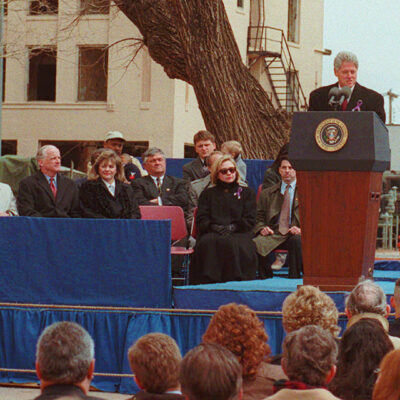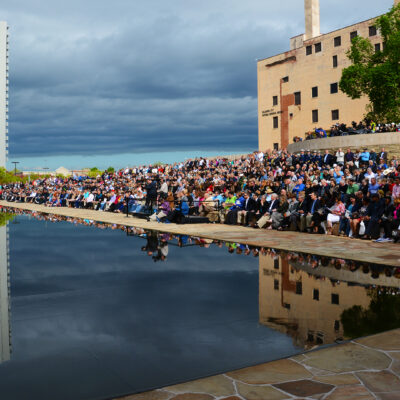Lesson Plan
Remembrance: The Process of Memorialization
For hundreds of years, Americans have honored those who have died in wars and other tragic events through the construction of memorials. These tributes offer places to grieve and become places of remembrance, comfort, and reflection. They can also provide the feeling of connectedness to those who were lost. It is because of the public’s commitment to ensure we never forget those who were killed, those who survived and those changed forever, that the Oklahoma City National Memorial & Museum was created.
Few could believe that a fellow American, a decorated soldier, would park a truck loaded with a bomb at a federal building, killing 168 people and destroying countless other lives. Within hours, individuals unwilling to give up hope started creating a spontaneous memorial. Cards of encouragement, stuffed animals and other symbols of hope and comfort were left on a chain-link fence erected to protect the crime scene. From the spontaneous memorial created just moments after the bombing to the Outdoor Symbolic Memorial which opened in 2000, memorials guarantee we will never forget.
Lesson Summary
Students will watch brief video interviews with people involved in the creation of the Oklahoma City National Memorial and research another memorial in the United States. Students will investigate what purpose memorials serve in the community and develop their own opinion on memorialization.
- Essential Questions: Why do communities need memorials? How do memorials assist the grieving? What makes a successful memorial?
- Time frame: 1 class period
- Subject(s): Social Studies, United States History, Oklahoma History, English
Materials Needed
- Access to Oklahoma National Memorial & Museum website to view videos
Lesson
- Ask students, “What is a memorial? How is a memorial different from a monument or a landmark?”
-
- A memorial honors a notable person who has died or a person or group of people who died in a notable event, such as the USS Arizona Memorial at Pearl Harbor.
- A monument honors someone notable or a special event, such as the Washington Monument in Washington, D.C.
- A landmark is a significant historical structure that illustrates the heritage of the place, such as the Gateway Arch in St. Louis.
- Show videos regarding the Memorialization process from this website.
- View the Outdoor Symbolic Memorial podcast narrated by the designers, Hans and Torrey Butzer.
- Discuss other U.S. memorials, including spontaneous memorials, their components and/or symbolism. Include in your discussion the concept of culture and memory, and why communities feel that memorials are important.
- Assessments
-
- (Grades 3-5) Select another U.S. Memorial and compare and contrast its components with the Oklahoma City National Memorial. Create a video, PowerPoint, photo collage or other project to share your findings with the class.
- (Middle/High School) Research another memorial to learn more about how it was created, why certain components were used, the symbolism, and how the memorial helps the community heal and remember. Include your philosophy of what memorials in general mean to you. Are memorials important? What purpose do they serve in society? Create a plan for the most effective way to share this information with your class.
Oklahoma Academic Standards for Social Studies: Oklahoma Studies Content Standard 12; grade 3:
Identify and describe the historic significance of state and local landmarks including the Buffalo Soldiers’ Old Post at Fort Sill, the Nellie Johnstone Number 1, the Oklahoma Capitol, Route 66, and the Oklahoma City National Memorial.
Oklahoma Academic Standards for Social Studies: United States Studies Content Standard 2:C; grade 4:
Identify the historic significance of major national monuments, historic sites, and landmarks including the Jefferson and Lincoln Memorials, the Washington Monument, the White House, the United States Capitol, the United States Supreme Court, Mount Vernon, Monticello, Colonial Williamsburg, Jamestown Historic Site, Dr. Martin Luther King, Jr. National Historic Site in Atlanta, Ellis Island, the Statue of Liberty, the 9/11 memorials, Independence Hall, the Jefferson National Expansion Memorial/Gateway Arch in St. Louis, the Oklahoma City National Memorial, Mount Rushmore, Little Bighorn National Monument, the Golden Gate Bridge, and Pearl Harbor Park.
Oklahoma Academic Standards for Social Studies; Oklahoma History Content Standard 5:10; grades 9-12:
Cite specific textual and visual evidence to analyze the causes and effects of the domestic terrorist attack on the Murrah Federal Building in Oklahoma City, including the responses of Oklahomans to the event, the concept of the Oklahoma Standard and the creation of the Oklahoma City National Memorial & Museum.
Oklahoma Academic Standards for English Language Arts Standard 1.W.1; grades 6-12
Students will give formal and informal presentations in a group or individually, organizing information and determining appropriate content and purpose for audience.
Oklahoma Academic Standards for English Language Arts Standard 3 R 4; grades 6-11
Students will evaluate literary devices to support interpretations of literary texts (symbolism).
Common Core Standards for ELA; Speaking and Listening #2; grades 6-12
Integrate and evaluate information presented in diverse media and formats, including visually, quantitatively, and orally.
National Council for the Social Studies 4.g; grades 6-12:
Social studies programs should include experiences that provide for the study of individual development and identity, so that the learner can analyze a particular event to identify reasons individuals might respond to it in different ways.





